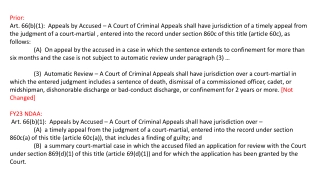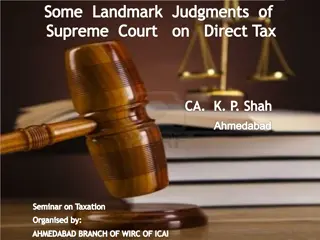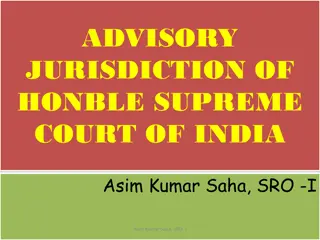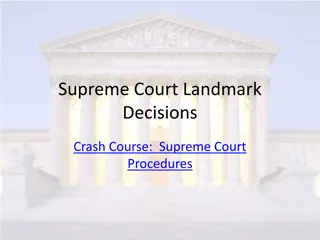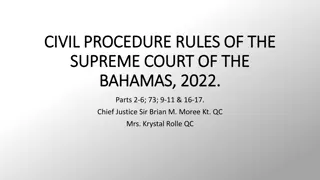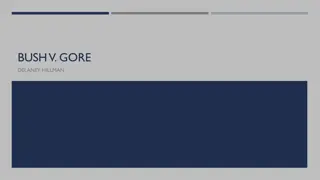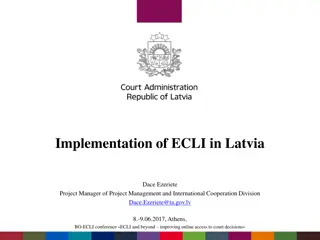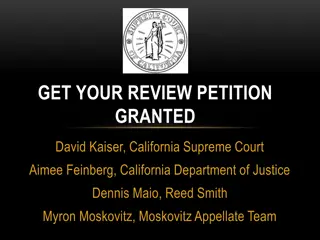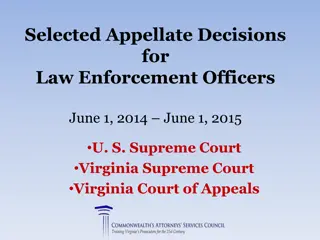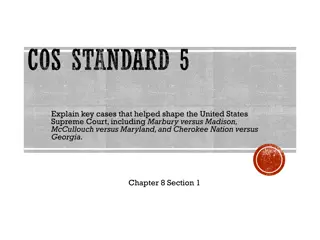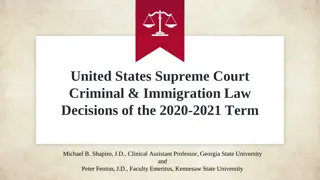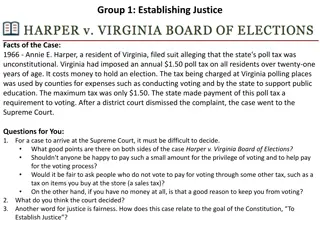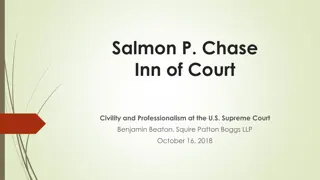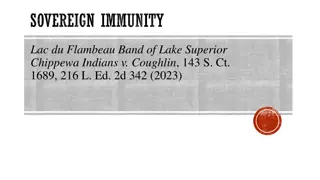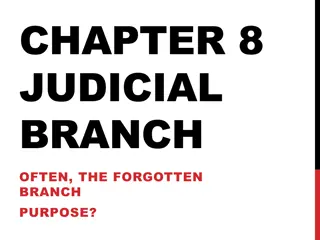Overview of Recent California Supreme Court Decisions and Statistics
Review recent California Supreme Court decisions, including discussions by legal professionals and statistics on filings, opinions, petitions, and voting disagreement rates. Insights on court workload trends are also provided.
Download Presentation

Please find below an Image/Link to download the presentation.
The content on the website is provided AS IS for your information and personal use only. It may not be sold, licensed, or shared on other websites without obtaining consent from the author. Download presentation by click this link. If you encounter any issues during the download, it is possible that the publisher has removed the file from their server.
E N D
Presentation Transcript
REVIEW OF RECENT CALIFORNIA SUPREME COURT DECISIONS Moderator: Danny Chou (Santa Clara County Counsel s Office) Rex Heinke (Akin, Gump, Strauss, Hauer & Feld LLP) Rory Little (UC Hastings College of Law) Jeremy Rosen (Horvitz & Levy) Darien Shanske (UC Davis School of Law)
INTRODUCTION Danny Chou
JUSTICES OF THE CALIFORNIA SUPREME COURT Left to right, standing: Justice Mariano-Florentino Cu llar (2014), Justice Carol A. Corrigan (2006), Justice Goodwin H. Liu (2011), and Justice Leondra R. Kruger (2015) Left to right, seated: Justice Kathryn M. Werdegar (1994), Chief Justice Tani G. Cantil-Sakauye (2011), and Justice Ming W. Chin (1996) 3
MOST RECENT COURT STATISTICS (SEPT. 1, 2015 AUG. 31, 2016) FROM A YEAR IN REVIEW AT THE SUPREME COURT OF CALIFORNIA: SEPTEMBER 1, 2016 AUGUST 31, 2016 (NOV. 10, 2016) Filings 7,963 Written Opinions 78 Petitions for Review 4,206 Civil 35 Automatic Appeals 9 Criminal 21 Habeas Petitions Related to AAs 44 Automatic Appeals 22
VOTING DISAGREEMENT AND DISSENT RATES BY PERCENTAGE (NUMBER OF CASES) SEPT. 1, 2015 AUG. 31, 2016 DERIVED FROM GERALD F. UELMAN S WORK Justice Cantil- Sakauye Chin Corrigan Werdegar Liu Cuellar Kruger Dissent Rate Cantil- Sakauye N/A 7.8 (6) 7.8 (6) 7.8 (6) 7.8 (6) 6.5 (5) 7.8 (6) 5.2 (4) Chin Corrigan Werdegar Liu Cuellar Kruger 7.8 (6) 7.8 (6) 7.8 (6) 7.8 (6) 6.5 (5) 7.8 (6) N/A 7.8 (6) 15.6 (12) 15.6 (12) 14.3 (11) 15.6 (12) 7.8 (6) N/A 7.8 (6) 7.8 (6) 6.5 (5) 7.8 (6) 15.6 (12) 7.8 (6) N/A 5.2 (4) 3.9 (3) 2.6 (2) 15.6 (12) 7.8 (6) 5.2 (4) N/A 3.9 (3) 2.6 (2) 14.3 (11) 6.5 (5) 3.9 (3) 3.9 (3) N/A 3.9 (3) 15.6 (12) 7.8 (6) 2.6 (2) 2.6 (2) 3.9 (3) N/A 13 (10) 5.2 (4) 2.6 (2) 2.6 (2) 1.3 (1) 2.6 (2)
MORE COURT STATISTICS (FROM 2016 COURT STATISTICS REPORT: STATEWIDE CASELOADS TREND) Fiscal Year Filings Petitions for Review Automatic Appeals (AAs) Habeas Petitions Related to AAs 47 41 31 46 44 34 29 38 35 45 Written Opinions FY 2015 FY 2014 FY 2013 FY 2012 FY 2011 FY 2010 FY 2009 FY 2008 FY 2007 FY 2006 7,868 7,913 8,027 9,232 10,328 9,759 9,486 10,752 9,198 9,465 4,038 4,134 4,191 4,620 4,984 5,128 5,159 5,911 5,101 5,404 18 19 13 18 22 29 24 17 17 20 76 85 94 87 98 96 116 116 113 125
SIGNIFICANT INTERGOVERNMENTAL DECISIONS Darien Shanske
EMINENT DOMAIN, PART I City of Perris v. Stamper (2016) 1 Cal.5th 576 Questions Presented: 1) Who decides Nollan/Dolan questions?; 2) How to analyze a city dedication requirement that was put in place when it was probable at the time the dedication requirement was put in place that the property designated for public use was to be included in the project for which the property is being condemned ? Holdings: 1) Judge; 2) Such a dedication requirement is to be ignored, which means, at the least in theory, that the value of the property to be condemned should reflect the additional value created by the project.
EMINENT DOMAIN, PART II Property Reserve, Inc. v. Superior Court (2016) 1 Cal.5th 151 Question Presented: Assuming a taking, do current statutes governing precondemnation entry and testing satisfy the California takings clause? Holding: Yes, once those statutes are reformed to allow the property owner the opportunity to obtain a jury determination as to damages.
INTERGOVERNMENTAL RELATIONS, PART I Monterey Peninsula Water Management Dist. v. PUC (2016) 62 Cal.4th 693 Question Presented: Can the PUC regulate the fees of a water district when the fees in question were essentially mitigation fees charged to a public utility over which the PUC did have jurisdiction? Holding: No.
INTERGOVERNMENTAL RELATIONS, PART II Department of Finance v. Commission on State Mandates (2016) 1 Cal.5th 749 Question Presented: In general, the state must reimburse local governments for state-imposed mandates. One exception is for mandates imposed by the federal government. Is reimbursement required when a state-level agency imposes a mandate as part of a federal regulatory program that the state agency administers? Holding: Reimbursement is required because federal law did not compel the state agency to impose the challenged mandates.
PUBLIC RECORDS ACT LA County Board Of Supervisors V. Superior Court, (Dec. 29, 2016, S226645) __ Cal.5th __ [2016 WL 7602131] Question Presented: Does the attorney-client privilege shield invoices from an outside law firm from California Public Records Act Requests? Holding: Yes, as to active and pending cases, but not concluded cases.
THE DOG THAT DIDNT BARK: EDUCATION CASES The Court denied review in two key education cases: Vergara v. California (Cal. 2016) 209 Cal.Rptr.3d 532. This case posed the question whether California s teacher tenure rules violated the state constitution and in particular its equal protection clause. The trial court ruled for the plaintiffs but the Court of Appeal reversed. Campaign for Quality Education v. State of California (2016) 246 Cal.App.4th 896. This case posed the question whether the California Constitution promises some minimal level of educational quality and whether the current California educational system falls below that level. The trial court ruled against the plaintiffs and a divided Court of Appeal affirmed. Three justices dissented from the denial of the petitions (Chin, Cuellar and Liu) and Liu and Cuellar wrote significant dissents.
SIGNIFICANT CIVIL DECISIONS Rex Heinke Jeremy Rosen
Baltazar v. Forever 21, Inc. (2016) 62 Cal.4th 1237 Employee challenged an arbitration agreement (which precluded a court trial on an action alleging harassment, discrimination, and retaliation) as unconscionable, because it allowed either party to seek preliminary injunctive relief, but that remedy was more likely to be used by the employer. Supreme Court ruled that the arbitration agreement was not substantively unconscionable because the injunctive relief clause merely restated the parties undisputed statutory rights under the California Arbitration Act.
Kilby v. CVS Pharmacy, Inc. (2016) 63 Cal.4th 1 Supreme Court interpreted California wage order requirements that provide: [a]ll working employees shall be provided with suitable seats when the nature of the work reasonably permits the use of the seats. It found that the nature of the work refers to an employee s tasks at a given location rather than the entire range of duties anywhere on the jobsite, and whether the work reasonably permits sitting is determined based on the totality of the circumstances, including but not limited to, the physical layout of the workplace and an employer s business judgment.
Webb v. Special Elec. Co., Inc. (2016) 63 Cal.4th 167 Supreme Court ruled that a company that supplies hazardous raw material to a product manufacturer can be relieved of a duty to warn a consumer under the sophisticated intermediary doctrine, but only if the supplier shows: (1) it warned or sold to a knowledgeable intermediary; and (2) it actually and reasonably relied on the intermediary to convey warnings to end users. In this case, the Court found substantial evidence supporting finding that supplier did not reasonably rely on the intermediary because although the intermediary was sophisticated on asbestos in general, it did not necessarily know the particular risk posed by the type of asbestos at issue.
Nickerson v. Stonebridge Life Ins. Co. (2016) 63 Cal.4th 363 Insured appealed reduction of a punitive damage award for wrongful denial of hospitalization benefits. Supreme Court ruled that when determining whether a punitive damage award comports with due process by calculating the ratio of punitive to compensatory damages, attorney fees must be included as compensatory damages.
Ramos v. Brenntag Specialties, Inc. (2016) 63 Cal.4th 500 Foundry worker sued companies that supplied products for the foundry s manufacturing process because the products allegedly sickened the worker. Suppliers asserted the component parts doctrine as a defense, which immunizes suppliers from strict liability for other manufacturer s products that incorporate suppliers components. The Supreme Court rejected this defense because the doctrine does not apply when the component is used in the manner intended by the supplier rather than being incorporated into a different end product.
Sandquist v. Lebo Automotive, Inc. (2016) 1 Cal.5th 233 4-3 decision. Supreme Court held that an arbitrator, and not a court, may decide whether an arbitration agreement permits a class-wide arbitration where the arbitration agreement allocates that decision to the arbitrator. It also clarified that its decision rested on California law, and that the Federal Arbitration Act did not require a contrary conclusion.
Baral v. Schnitt (2016) 1 Cal.5th 376 Supreme Court resolved a split in the Courts of Appeal, ruling that an anti-SLAPP motion may target portions of a single cause of action even if the entire cause of action is not within the scope of the anti-SLAPP statute. In deciding, it concluded that if a challenge to a portion of a cause of action was not allowed, this would unduly limit the relief contemplated by the Legislature because a plaintiff could include non-protected activity in a cause of action and prevent a defendant from striking protected activity from the same cause of action.
City of Montebello v. Vasquez (2016) 1 Cal.5th 409 Supreme Court held that the anti-SLAPP statute applies to actions against city council members for voting on contracts in which they have a financial interest. It also resolved a conflict in the Courts of Appeal, ruling that the statute s exemption for public enforcement actions does not apply in cases where a City brings an action in its own name and with private counsel, rather than in the name of the People by a public prosecutor.
Laffitte v. Robert Half Intern. Inc. (2016) 1 Cal.5th 480 Supreme Court joined the overwhelming majority of federal and state courts in holding that attorney fees for counsel in a class action may be calculated based on a percentage of the common fund recovered in the litigation. However, a lodestar calculation may be used to check reasonableness of the fee. It clarified that its decision in Serrano v. Priest (1977) 20 Cal.3d 25, which permitted only fees based on the actual time an attorney spent on a case, applies only to private attorney general cases.
Bristol-Myers Squibb Company v. Superior Court (2016) 1 Cal.5th 783 Supreme Court found that Bristol-Myers Squibb conducted activities in California sufficiently related to nonresident plaintiffs injuries from a drug such that it was subject to jurisdiction in California despite not being incorporated or headquartered there. The Court relied on Bristol-Myers Squibb s extensive contacts with California, namely extensive marketing and distribution of the injury-causing drug, revenues fro the drug s sales, and hundreds of California employees.
Friends of the College of San Mateo Gardens v. San Mateo Community College District (2016) 1 Cal.5th 937 A community college district approved changes to a plan years after its inception, including demolishing a building that was originally slated for renovation and renovating two other buildings originally slated for demolition. Supreme Court ruled that a new Environmental Impact Report (EIR) was not required, clarifying that a new EIR is not necessary unless there are new, previously unstudied significant environmental impacts.
Kesner v. Superior Court (2016) 1 Cal.5th 1132 Supreme Court held that landowners and employers owe a duty of ordinary care to prevent secondary exposure (domestic or take-home exposure) to asbestos, which occurs when a worker directly exposed to a toxin carries it home and a household member is in turn exposed. However, it clarified this duty extends only to potential plaintiffs that are members of the worker s household.
Augustus v. ABM Security Services, Inc. (Dec. 22, 2016, S224853) __ Cal.5th __ [2016 WL 7407328] Security services company required employee security guards to remain on call during rest periods, allegedly in violation of California wage orders. Supreme Court ruled that wage orders mandate employers to provide 10-minute rest periods every four hours, and during those rest periods, employers must relieve employees of all duties and relinquish any control over how employees spend their time, including keeping them on call.
SIGNIFICANT CRIMINAL DECISIONS Rory Little
SUMMARY OF 2016 CRIMINAL CASES Approximately 48 written decisions in calendar year 2016 (although it depends on what you count as criminal ). Most are unanimous. The Chief Justice and Justices Chin, Corrigan, and Kruger tend to be the criminal law experts. But all of course have broad exposure and experience.
2016 CAPITAL CASES 26 cases, including 6 reversals. All but 3 were unanimous with a single opinion. All but ONE were unanimous as to result. Opinions relatively evenly distributed. Every Justice had at least one, with the Chief Justice and Justice Liu authoring 5 each. Reversals were authored by the Chief (2), Corrigan, Liu, Kruger, Cuellar. The only divided reversal was in Justice Kruger s case (Grimes). The Chief dissented, joined by Justices Chin and Corrigan. Evidentiary issue: whether statements against interest should be redacted to admit only the portions directly against interest. Majority says no.
MORE ON 2016 CAPITAL CASES There is geographic disparity, racial disparity, and the most dramatic: gender disparity. 2016 cases were from 14 (out of 58) counties. LA leads with 7; Riverside and San Joaquin have 3; other 11 counties have either 2 or 1. Significant percentage (66%) of death row inmates are persons of color. Of 741 persons on California s death row, 35% are black (267 of 741), while only 7% of California s population is black. Another 185 on death row (25%) are Latino (39% of population). 29 (4%) are Asian (15% of population), and 11 are Native American. There was one female capital defendant in the 2016 capital opinions. There are 20 women total on California s death row, less than 1%. (Nationally, 2% or 55 of 2,943 on death row are women).
SIGNIFICANT 2016 CAPITAL CASES People v. Grimes (2016) 1 Cal.5th 698: Reversed penalty (4-3, Kruger; CJ dissented w/ Chin and Corrigan). People v. Nelson (2016) 1 Cal.5th 513: Unanimously reversed penalty (5-2. Liu; Corrigan dissented w/ Chin on lying in wait aggravator). People v. Zagora (2016) 1 Cal.5th 21: Reversed penalty (7-0, Cuellar).
PROP. 66: DEATH PENALTY REFORM AND SAVINGS ACT. Passed 51%-49%. (Prop 62 to repeal the death penalty failed 54%-46%.) Stayed by Supreme Court on Dec. 21 pending briefing and possible argument. Dramatically restructures how capital challenges -- appeals and habeas -- will be handled. (Similar, but hardly identical, to the federal AEDPA (1996)). -- Brings process closer to process in most other States with death penalty. -- 35 US juris. have death penalty (including federal and military); 19 do not. Calls any collateral attack a habeas corpus action. Cases go to original sentencing judge. Direct appeal and state habeas must be completed within 5 years. Must appoint counsel as soon as possible. Briefing extensions for only compelling or extraordinary reasons. -- Counsel on indigent appeals lists must agree to take capital cases. -- Brief must be filed within one year of appointment of counsel. -- Send all capital habeas filings back to original sentencing judge. -- HRC can t assist in federal challenge unless feds will cover the cost.
OTHER SIGNIFICANT 2016 CRIMINAL DECISIONS
People v. Sanchez (2016) 63 Cal.4th 665 (Corrigan, 7-0) Case-specific out of court statements of fact relied upon by expert for opinion are hearsay. Inadmissible unless independently proved by competent evidence or covered by a hearsay exception. Further, if testimonial, then a separate Confrontation Clause issue under Crawford. Witness statements made to investigating law enforcement are generally testimonial.
In re Richards (2016) 63 Cal.4th 291 (Cantil-Sakauye, 7-0;Corrigan concurring opinion; Liu concurring opinion) Recanted expert testimony (here, bite mark testimony) constitutes false evidence under California habeas statute. Justices Liu and Corrigan battle over whether prior juries who were unable to reach verdicts without the expert evidence is a relevant factor or not.
HARRIS V. SUPERIOR COURT (2016)1 CAL.5TH 984 (CHIN, 7-0) The fact that Prop. 47 results in a significant reduction in sentence (here, from 6 years to misdemeanor) does not give the People grounds to rescind the plea agreement. The intent of the People in enacting the Proposition was to reduce such sentences.
PEOPLE V. MACABEO (2016) 1 CAL.5TH 1206 (CORRIGAN, 7-0) The warrantless search of the cellphone [which revealed photos of underage girls ] of a person detained on the street, not yet arrested, violates the Fourth Amendment. Because a reasonably well-trained officer would have so known, no good-faith exception applies.
PEOPLE V. RODRIGUEZ (2016) 1 CAL.5TH 676 (CUELLAR, 7-0;CORRIGAN FILED BRIEF CONCURRENCE) If prosecutor refiles a case, a motion to suppress that was granted in the prior filing must statutorily go to the same judge, even if the refiled case is now assigned to a different court, unless judge cannot in good faith truly be available.
People v. Vidana (2016) 1 Cal.5th 632 (Chin, 7-0) Charges for grand theft by larceny and embezzlement, when based on the same act, can produce only one conviction. The theft consolidation statute means what it says. Similar: People v. Corpening (Dec. 29, 2016) (Cuellar, 7-0): the same physical act here the taking of a car can be punished only once under Penal Code 654(a). So a five-year sentence for car-jacking here stands, but an addition one year for robbery based on that same taking must be stayed.
People v. Armstrong (2016)1 Cal.5th 432 (Cantil-Sakuaye, 7-0; reverses death penalty) Trial court erred in removing juror for refusal to deliberate. The record must reach a very high standard before court may do this.
People v. Zaragoza (2016) 1 Cal.5th 21 (CUELLAR, 7-0; reverses death penalty). Dismissal of prospective juror based solely on written answers to questionnaire was error. Burden is on prosecution and ambiguous written answers cannot suffice, must be clear. (In-person voirdire usually required).
People v. Espinoza (2016)1 Cal.5th 61 (Cantil-Sakauye, 7-0) Defendant who chooses to represent himself and then fails to appear after first day of trial already begun, has no one but himself to blame for any failure to present a defense. He is properly convicted of various felonies; no abuse of discretion in continuing with the trial without defense counsel.
People v. Castillolopez (2016) 63 Cal.4th 322 (Kruger, 7-0) A Swiss Army pocket knife that is open is not locked into position so it is not a dirk or dagger whose concealed carrying is criminalized under Penal Code 21310 as defined in Penal Code 16470. Blade must be fixed or immobile. Legislative history since 1917 is reviewed.
PEOPLE V. WADE (2016) 63 Cal.4th 137 (Chin, 7-0) Loaded firearm in a backpack is on the person for carrying prohibition statute.
SMALLER TIDBITS People v. Garcia(2016) 62 Cal.4th 1116: Entry into separate bathroom in store, after burglary of store, cannot support second burglary conviction. (Cuellar, 5-2; Kruger concurred joined by Liu, arcane (but not unimportant) dispute over history and meaning of burglary) People v. O Malley(2016) 62 Cal.4th 944: Capital case. Inter alia, peremptory strike on basis that potential juror was an amateur magician and a renter does not establish prohibited discriminatory intent. (Kruger, 7-0) People v. Safety Nat. Cas. Corp. (2016) 62 Cal.4th 703: Highly technical and comprehensive discussion of bail and appearance requirements. When defendant has notice of a scheduled hearing and fails to appear without a written waiver or sufficient excuse, bail is properly forfeited. (Chin, 7-0)
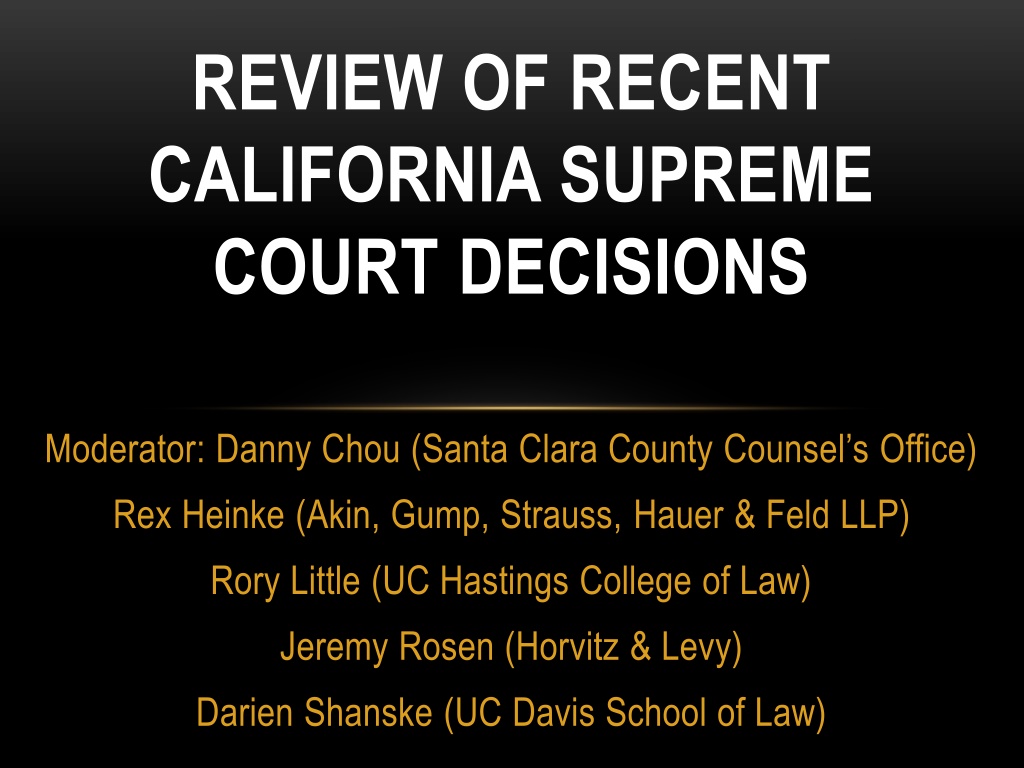
 undefined
undefined
 undefined
undefined
